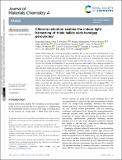Files in this item
Chlorine retention enables the indoor light harvesting of triple halide wide bandgap perovskites
Item metadata
| dc.contributor.author | Wang, Shaoyang | |
| dc.contributor.author | Edwards, Paul R. | |
| dc.contributor.author | Abdelsamie, Maged | |
| dc.contributor.author | Brown, Peter | |
| dc.contributor.author | Webster, David | |
| dc.contributor.author | Ruseckas, Arvydas | |
| dc.contributor.author | Rajan, Gopika | |
| dc.contributor.author | Neves, Ana I. S. | |
| dc.contributor.author | Martin, Robert W. | |
| dc.contributor.author | Sutter-Fella, Carolin M. | |
| dc.contributor.author | Turnbull, Graham A. | |
| dc.contributor.author | Samuel, Ifor D. W. | |
| dc.contributor.author | Jagadamma, Lethy Krishnan | |
| dc.date.accessioned | 2023-06-01T11:30:19Z | |
| dc.date.available | 2023-06-01T11:30:19Z | |
| dc.date.issued | 2023-06-21 | |
| dc.identifier | 286991584 | |
| dc.identifier | 5ec20f28-9fe7-4186-998a-67fd43538e11 | |
| dc.identifier | 85163941363 | |
| dc.identifier.citation | Wang , S , Edwards , P R , Abdelsamie , M , Brown , P , Webster , D , Ruseckas , A , Rajan , G , Neves , A I S , Martin , R W , Sutter-Fella , C M , Turnbull , G A , Samuel , I D W & Jagadamma , L K 2023 , ' Chlorine retention enables the indoor light harvesting of triple halide wide bandgap perovskites ' , Journal of Materials Chemistry A , vol. 11 , no. 23 , pp. 12328-12341 . https://doi.org/10.1039/d3ta01784b | en |
| dc.identifier.issn | 2050-7488 | |
| dc.identifier.other | Jisc: 1115483 | |
| dc.identifier.other | publisher-id: d3ta01784b | |
| dc.identifier.other | ORCID: /0000-0002-4339-2484/work/136288726 | |
| dc.identifier.other | ORCID: /0000-0001-9114-3522/work/136288872 | |
| dc.identifier.uri | https://hdl.handle.net/10023/27726 | |
| dc.description | Funding: LKJ acknowledges funding from UKRI-FLF through MR/T022094/1. LKJ also acknowledges, Professor Iain Baikie for assistance with the work function and APS measurements, and Professor Phil King and Gordon Kentish, School of Physics and Astronomy, University of St Andrews for the XRD measurements and would like to acknowledge (EPSRC): EP/T023449/1. This research used resources of the Advanced Light Source, a U.S. DOE Office of Science User Facility under contract no. DE-AC02-05CH11231. Work was performed at beamline 12.3.2, beamline scientist Nobumichi Tamura. M. A. acknowledges support by the US Department of Energy, Office of Science, Office of Basic Energy Sciences, Materials Sciences and Engineering Division under Contract No. DE-AC02-05-CH11231 (D2S2 program KCD2S2). Work at the Molecular Foundry was supported by the Office of Science, Office of Basic Energy Sciences, of the U.S. Department of Energy under Contract No. DE-AC02-05CH11231. IDWS acknowledges funding from EPSRC through EP/l017008/1. | en |
| dc.description.abstract | Indoor photovoltaics are receiving tremendous attention due to the continuous development of the Internet of Things. The present study reports how the fast processing of the triple halide perovskite enables the retention of chlorine and the beneficial role of chlorine in enhancing the indoor light harvesting of a wide bandgap triple anion (TA) perovskite CH3NH3PbI2.6Br0.2Cl0.2. The kinetics of chlorine incorporation/escape investigated by in situ grazing incidence wide-angle X-ray scattering revealed the escape of chlorine after the first ten minutes of thermal annealing and the findings were corroborated with elemental analysis by wavelength dispersive X-ray spectroscopy. The best-performing TA perovskite indoor-photovoltaic device achieved a steady-state power conversion efficiency (PCE) of 25.1% with an output power density of ∼75 μW cm−2 under 1000 lux indoor illumination (0.3 mW cm−2 irradiance). Improved crystalline quality, reduced density of trap states and longer carrier lifetime were achieved by the triple anion alloying method. The detrimental role of the commonly used hole transporting layer (HTL) of Spiro-MeOTAD under indoor lighting conditions leading to J–V hysteresis was also investigated, which could then be effectively suppressed by replacing Spiro-MeOTAD with undoped P3HT. The optimized TA perovskite indoor PV cells were then successfully used to wirelessly power a textile fiber-based temperature sensor. The results from the present study demonstrate a novel route to incorporate chlorine effectively and maximize the steady state power output from halide perovskite indoor photovoltaic devices and their promising potential for the IoT industry. | |
| dc.format.extent | 14 | |
| dc.format.extent | 1470117 | |
| dc.language.iso | eng | |
| dc.relation.ispartof | Journal of Materials Chemistry A | en |
| dc.rights | Copyright The Author(s). This article is licensed under a Creative Commons Attribution-NonCommercial 3.0 Unported Licence. | en |
| dc.subject | QD Chemistry | en |
| dc.subject | QC Physics | en |
| dc.subject | DAS | en |
| dc.subject | SDG 7 - Affordable and Clean Energy | en |
| dc.subject | MCC | en |
| dc.subject.lcc | QD | en |
| dc.subject.lcc | QC | en |
| dc.title | Chlorine retention enables the indoor light harvesting of triple halide wide bandgap perovskites | en |
| dc.type | Journal article | en |
| dc.contributor.sponsor | EPSRC | en |
| dc.contributor.sponsor | EPSRC | en |
| dc.contributor.institution | University of St Andrews.Arctic Research Centre | en |
| dc.contributor.institution | University of St Andrews.School of Physics and Astronomy | en |
| dc.contributor.institution | University of St Andrews.Energy Harvesting Research Group | en |
| dc.contributor.institution | University of St Andrews.Organic Semiconductor Centre | en |
| dc.contributor.institution | University of St Andrews.Centre for Energy Ethics | en |
| dc.contributor.institution | University of St Andrews.Sir James Mackenzie Institute for Early Diagnosis | en |
| dc.contributor.institution | University of St Andrews.Centre for Biophotonics | en |
| dc.contributor.institution | University of St Andrews.Condensed Matter Physics | en |
| dc.identifier.doi | 10.1039/d3ta01784b | |
| dc.description.status | Peer reviewed | en |
| dc.identifier.grantnumber | EP/T023449/1 | en |
| dc.identifier.grantnumber | ep/l017008/1 | en |
This item appears in the following Collection(s)
Items in the St Andrews Research Repository are protected by copyright, with all rights reserved, unless otherwise indicated.

